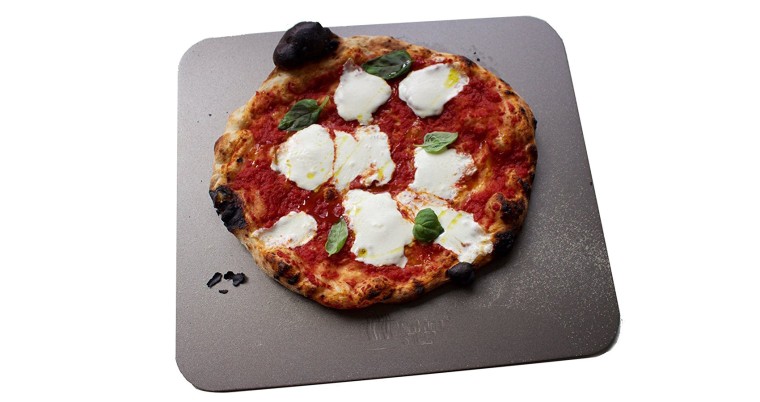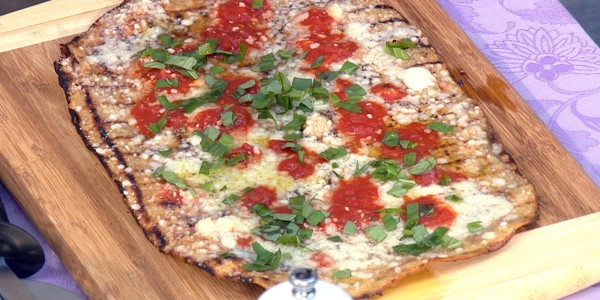Legendary pizza maker Chris Bianco is stopping by TODAY to share pizza making tips and recipes from his new cookbook "Bianco: Pizza, Pasta, and Other Food I Like."
He shows us how to make homemade Margherita pizza from scratch — and there's no fancy pizza oven required.
TODAY has affiliate relationships, so we may get a small share of the revenue from your purchases. Items are sold by the retailer, not by TODAY.
Almost everyone has tried a Margherita pizza, or at least a cheese pizza. For me, that widespread familiarity was an opportunity to exceed people's expectations, to check off the requisite boxes but go above and beyond with optimal ingredients.
Pizza-making tips and techniques
Delicious dough
Shaping: Hold the top edge of a piece of dough with both hands, allowing the bottom edge to touch the work surface, and carefully move your hands around the edges to form a round of dough. You have to find your own style, but I usually just cup my hand into a C-shape, turn my hand knuckle side up, and drape the dough off it, allowing gravity to do its work, so it gently falls onto the floured table. Imagine you're turning a wheel. Hold that dough aloft, allowing its weight to stretch it into a rough 10-inch round.
Don't put any pressure on it by pulling or stretching it, just let gravity do the job, you want that aeration and cragginess. Keep it moving and the dough will start to relax. When you're ready to make a pizza, lay the dough on a lightly floured pizza peel or inverted baking sheet. Gently press out the edges with your fingers. You will start to see some puffiness or bubbles. Jerk the peel to make sure the dough is not sticking. If it is, lift the dough and dust the underside with a little flour. Tuck and shape it until it's a happy round.
Proofing:Normally, chefs proof dough for three hours, then divide it into balls and let it proof for another hour before baking it. But what happens if you proof it for seven hours? What if you let it go for 24 hours? It will be different, and that difference might be more to your taste than the basic dough. At three hours for the first proof, you will have a dough that will brown more quickly than a dough that's proofed for 14 hours, because the yeast will not have converted as many of the sugars. The longer the dough proofs, and the more sugars are converted, the more it will have that alcoholic smell of fermentation, and the more the sour flavors will develop.
Many people love those flavors — like a good sourdough bread — but with a basic pizza dough, I don't necessarily want that sharpness because I don't want them to dominate the flavors of the pizza toppings. That said, there is no wrong way to go here. Make the dough a few times, following the recipe, until you feel comfortable. Then start to play with it. Determine how long a proof you like.
Ingredients: Never forget, we're only dealing with four ingredients, and each one brings its own flavors and qualities to the pizza. Where you are in the world will play its part in how your pizza tastes. If you're making the dough in Iceland, it's going to be different than making it in Phoenix. The climate is different, so it may need to proof for a little longer than three hours to start. Your water will be different, and it will affect the flavor of your dough.
Sensational sauce
Tomatoes: Beautifully canned or jarred tomatoes, preferably organic, are a celebration of height-of-season produce. A moment captured in time and available to you long after summer has gone. Fresh tomatoes are not always the best choice for sauce. The window for perfect, ripe tomatoes isn't very long, and in winter, pallid grocery store tomatoes are going to give you a real bummer of a sauce. One of the many beauties of pizza is that it relies on ingredients you can always have on hand. You just need a well-stocked pantry.
Seasoning: Be alert to the salt content of whatever canned tomatoes you use. Don't just read the label: taste them before using them. Cooking will reduce the sauce and the saltiness will become more pronounced, so you want to be on the lighter side of salinity when you set out on the road to perfection, instead of already at the destination. Time is the invisible ingredient here, so if you can, let the sauce sit for about an hour so the flavors can marry. Of course, in our restaurants, we don't always have the luxury of that time and the sauce is still great.
Fresh herbs: Not all canned tomatoes include basil. This recipe calls for adding fresh basil to the sauce. If your tomatoes already include the herb, taste them and see if you want to take it a step further or if you're happy with them as is. We always add a few hand-bruised fresh leaves too.
Texture: You want to end up with a textured yet silky sauce. I like it when the sauce isn't uniform, when there are still bits and pieces of tomato. And I don't like using an immersion blender or food processor because these can bring out the bitterness of the seeds. A hand-crushed sauce has a better mouthfeel and won't be so one dimensional.
Perfect pizza
Baking: Using a pizza stone (I prefer one made of ultra-conductive steel) will give you an evenly cooked and crispy crust. You need to heat it for a solid hour at your oven's highest possible setting. Don't even bother putting your pizza together until the oven's been going for an hour.

Toppings: A Margherita made with high quality ingredients is perfect as is, but it's also a perfect canvas for other ingredients. Just remember that when you add or remove something from a pizza, you need to accommodate for that gain or loss, be it a matter of texture, moisture, flavor or anything else. For example, adding ricotta cheese could make your pizza more watery, so you might want to use a little less tomato sauce to balance things out. Always taste your mozzarella and your tomato sauce to see how salty they both are before throwing them on your pizza — and make a mental note of the flavor profile when choosing additional toppings.
Serving: Most traditional recipes call for basil to be cooked with the pizza, which is totally fine. I prefer tearing and rough-handling fresh basil leaves over the cooked pizza just before slicing and letting the heat release the aroma. The essential oils from the basil provide a pleasing texture and flavor profile. Serve the pizza hot out of the oven for the crispest texture and freshest flavor.
If you like that delicious pizza recipe, you should also try these:


